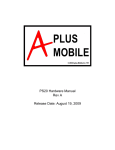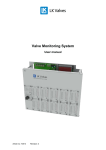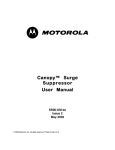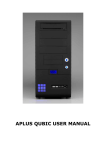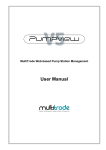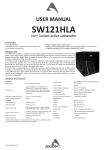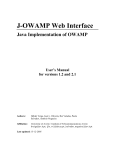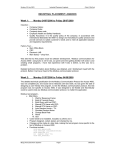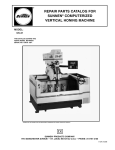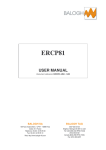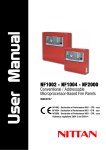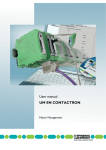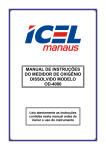Download A20-MC Hardware Manual Rev 8 Release Date
Transcript
A20-MC Hardware Manual Rev 8 Release Date: July 15, 2008 A20 User Manual Rev 8 Page 2 of 21 Table of Contents A20-MC Theory of Operation page 3 Glossary of Abbreviations page 3 A20-MC 3-Dimensional Images page 4 Key Switch page 5 Start Up Sequence page 5 Operating Systems page 6 Environmental Specifications page 7 Input Protection Clamp page 7 APM-I/O Connector Cable page 8 Input Voltage Considerations page 9 Battery System Capabilities page 9 Operation page 10 Repairs page 10 Frequently Asked Questions page 11 Outline Drawing page 13 Custom Connector Pin Out page 14 BIOS Reset Key Sequence page 15 BIOS Video Setup Screen page 15 LCD Monitor Panel Type BIOS Setting page 16 A20 System Watchdog Timer page 16 Memory Address Map page 17 I/O Port Address Map page 18 IRQ page 20 DMA page 20 Aplus Mobile Contact Information page 21 A20 User Manual Rev 8 Page 3 of 21 A20-MC Theory of Operation You will notice that this computer doesn’t crash except when software is buggy. That is because the CPU and system ALWAYS has clean power available. It knows when you have main power or not and if the computer is running or not. If you turn the computer off through the Windows shutdown box on the main screen and the main power is still up, the A20 will just reboot the system in a few seconds. Conversely, if the system senses the main power is down, after a short delay, it will shut down Windows orderly as if you had shut it down yourself. The A20 system will go to sleep waiting for main power to come back up for a few seconds and then it will boot again. It will finish booting no matter what the power state and then check main power again to see if it needs to stay up or it needs to shutdown Windows. Glossary of Abbreviations A20-DH Aplus Mobile Harsh Remote Drive Interface with DVD/RW Slot Load Drive and USB Ports A20-HH Aplus Mobile Harsh USB 2.0 Hub, Aluminum Chassis A20-MC Aplus Mobile Harsh Environment DC Powered Computer APM-I/O Aplus Mobile Input/Output Cable BIOS Basic Input Output System BV Breakdown Voltage CF Compact Flash CPU Central Processing Unit DSK Disk HD LED OS Hard Drive Light Emitting Diode Operating System PWR Power SATA Serial-ATA UPS Uninterruptible Power Supply USB Universal Serial Bus A20 User Manual Rev 8 Page 4 of 21 A20-MC 3-Dimensional Images A20 User Manual Rev 8 Page 5 of 21 Key Switch To turn the computer on, turn key counterclockwise to ON position. Key can be removed in either position. The key switch is a true power disconnect. When the key is in the OFF position, the computer is physically disconnected from the outside world and internal UPS battery. When the computer is OFF, the computer cannot be powered. Cautions: DO NOT USE KEY TO TURN A20-MC ON OR OFF. Key is used for connecting or disconnecting power only. Use power supply to turn A20-MC ON or OFF. Do not leave the KEY in the ON position while not in use for extended periods. Extended periods could be defined as 5 days or more. This time may be shortened depending on temperature and age of the battery. Leaving the key switch ON leaves the battery engaged and will discharge the battery over time. When not in use, turn key clockwise to OFF position. Start Up Sequence 1. 2. 3. 4. 5. Connect peripheral cables required for your application. Connect unit to DC power source. Turn key counterclockwise to ON position. Apply DC power to turn unit ON. Red PWR LED should come ON and depending on your configuration, yellow UPS LED may flash detecting UPS or may remain OFF indicating power system status good. 6. If the yellow UPS LED is quickly flashing or if the blue CPU LED is quickly flashing, then the power system has identified an error and requires a reboot in the form of power cycling. 7. During normal operation, if the main power as indicated by the red PWR LED is interrupted, the yellow UPS LED will come ON to indicate UPS status is active. 8. The green DSK LED may remain lit or may flash indicating disk activity depending on HD or SATA configuration. A20 User Manual Rev 8 Page 6 of 21 Operating Systems • • • • • Some OS will require disabling the CF or HD in order to load your OS. Some OS will require the boot order & HD configuration screens to be set up specifically. Please consult your software literature or you may need to try several configurations if your OS hangs during installation. Enter BIOS by hitting DELETE key during boot up. The motherboard type is LV677. If your OS hangs during normal shut down sequence, please cycle power with key switch or unit will force the OS to shut down after a period of time and kill all system power. This is in order to save the UPS battery from excessive UPS discharge. If this is the case, it is normal to expect high inrush current when you turn it back ON due to the UPS battery’s depleted state. This will be limited by the power control, which may go into pulse charge condition to limit peak currents during this time. Slow flashing yellow UPS LED is normal. This indicates pulse charge. You must select hard drive boot order in BIOS. You must move your boot device to the front of the list on the boot order screen as well as setup the typical boot order in the Main BIOS screen. You will need to setup the configuration for your CF & SATA HD in the following BIOS screens. a. Go to BIOS b. Go to Integrated Peripherals c. Go to OnChip IDE Device and press Enter d. See the Boot Device Configuration Screen. You may choose system configuration or disable CF here. Next setup your boot drive order on a different BIOS screen and move your boot drive to the top of the list. a. Go to BIOS b. Go to Advanced BIOS Features c. Go to (2nd choice) Hard Disk Boot Priority and press Enter d. See selection of Boot Drives and move your Boot Drive to the top of the list. Windows • With Windows pre-loaded on your machine, the Administrator password is: “aplusmobile” • The CF is disabled in BIOS. It is a SLAVE on IDE1. Please go to BIOS to enable if used. Linux • The CF will be disabled in BIOS. It is a MASTER on IDE1. If you require a different configuration to load your OS, please alter BIOS configuration for CF & HD. • You may need to disable SATA HD if you are loading your OS on CF during installation. Also, you may need to disable CF if you are loading your OS on SATA HD during installation. You may enable either CF or HD after your OS is loaded. QNX • QNX may not shut down properly and hang. Check your QNX configuration if this is an issue. A20 User Manual Rev 8 Page 7 of 21 Environmental Specifications Storage Temperature -20 ~ 85°C (-4 ~ 185°F) Operational Temperature 0 ~ 60°C (32 ~ 140°F) Storage Shock (half sine wave) 1000 G / 1 ms Operational Shock (half sine wave) 300 G / 2ms, 160G / 1ms Input Protection Clamp This unit has an input protection clamp to protect from voltage transients induced by lightning and other transient voltage events. Features • • • • Bi-directional 5000W Peak Pulse Power capability on 10/1000µS waveform Repetition rate (duty cycle): 0.05% Response time: typically less than 1.0pS from 0 Volts to BV Power Input Clamp Maximum Ratings and Characteristics @ 25°C Ambient Temperature Rating Symbol Value Unit Peak Pulse Power Dissipation on 10/1000µS waveform PPPM Min 5000 Watts Peak Pulse Current of on 10/1000µS waveform IPPM 129 Amps PM(AV) 8 Watts IFSM 400 Amps Steady State Power Dissipation at TL=75°C, Lead Lengths .375”, (9.5mm) Peak Forward Surge Current, 8.3mS Single Half SineWave Superimposed on Rated Load, (JEDEC Method) A20 User Manual Rev 8 Page 8 of 21 Power Input Clamp Electrical Specification @ TAMB 25°C Reverse Stand off Voltage VR (Volts) 24.0 Breakdown Voltage VBR (Volts) @ IT MIN MAX 26.70 29.50 Test Current IT (mA) Maximum Clamping Voltage VC @ IPP (Volts) Maximum Peak Pulse Current IPP (A) Maximum Reverse Leakage IR @ VR (µA) 5 38.9 129.0 10 The transient voltage suppression specifications above are subject to change depending on the required input clamp voltage for the application. System can operate on voltages of up to 48VDC under special circumstances. Consult the factory. The input is 60V transient capable past the input clamp. Different clamp voltages are available for specific applications. APM-I/O Connector Cable STEREO AUD-OUT AMP-I/O MIC IN VIDEO CAPTURE IN COMP S-VIDEO* *COMP Y C The APM-I/O connector cable will bring AUDIO-OUT, MIC-IN and other options as specified in your system configuration, such as Video Capture. A20 User Manual Rev 8 Page 9 of 21 Input Voltage Considerations Nominal Operational Voltages 12 - 29VDC Operational voltages 0 - 30VDC (System runs on Internal UPS under 12V) Your unit may have a different input clamp depending on your application. The A20-MC power system is capable of regulating up to 60VDC, however this presents excessive power dissipation and is not recommended. This power front end also provides a +60 / -50VDC transient capability along with reverse battery protection and electronic fuse. You must provide an additional fused input to the unit for a catastrophic event. 10 - 20A fuse should be sufficient to prevent false tripping. Even though the A20-MC is fused internally, you must provide an additional 10 - 20A fused input. The unit may exhibit pulse charging continuously if ran at low line voltage (12.0VDC) due to current availability on the main power line. If mounting more than one system, please connect the power cable directly to the battery or main switch from battery in a star configuration to reduce power loss. Battery System Capabilities Replace with Panasonic LC-R121R3P battery only. Seal cover with GE RTV-133 or sensor safe silicone only. The battery is a sealed lead acid, non-spillable gel cell and is certified for air shipment. The battery uses a solid gel matt electrolyte and is available from Panasonic distributors. This is the same type of battery that is used in emergency lights. A20 User Manual Rev 8 Page 10 of 21 Operation • • • • • • • Applying power will turn ON the computer and boot your OS automatically. Power control system is always checking for the presence of main power and if the computer is running. If main power is present, the power control will check to see if the OS is booted. If not, it will attempt to boot OS. If it is unsuccessful after 25 attempts, the power control will put the system to sleep and you must cycle main power in order to boot OS again. If the power control senses main power is down for 8-14 seconds continuously, then it will initiate OS shutdown on UPS power. If main power comes back anytime during shutdown sequence and before it goes to sleep, it will attempt to reboot OS without requiring you to recycle the power. Power recycling is only required if system is fully asleep, otherwise the system will be fully automatic and should not require power cycling during normal operation. This is a rare situation. Once system has shutdown and gone to sleep (all front panel LEDs OFF), you must cycle main power to reboot system. The system will always try to boot OS if main power is present at any time, except when system has gone fully to sleep (i.e.: all front panel LEDs are OFF). 1. Turn ON main power. 2. System will boot itself and remain ON until main power is turned OFF. Turning OFF main power for a short period of time will initiate OS shutdown on UPS and sleep mode. Do not use the key switch to turn the unit ON and OFF. This will disconnect the UPS from the computer and will cause the computer not to shut down properly. Repairs The A20 is a sealed case and is very difficult to open. It is not recommended. All repairs should be done at the Aplus Mobile, Inc. factory or in extreme cases serviced by a qualified super-technician capable of aircraft system-level work. There are no user serviceable or replaceable parts inside the system. The CPU cannot be replaced without total disassembly of the case. Please consult the factory for any upgrades. A20 User Manual Rev 8 Page 11 of 21 Frequently Asked Questions Q: What is the bottleneck that seems to limit us to 3 Gig of available RAM even though 4 Gig is installed? A: It is the chipset's address limitations. The processor is capable. However Intel's mobile chipset has not caught up yet. We should see this in the next chipset release. It has been unclear when this bottleneck is going to be removed. We had anticipated that with the introduction of the Core 2 Duo, we would see a chipset upgrade as well, but it hasn't quite happened yet. Since there are no such things as 1.5GB memory modules, we have to use 2GB memory modules and charge accordingly. Intel is aware of this. Q: The system settings indicate that IDE 1 slave is a Transcend 2 Gig device. Is this a normal configuration for these things? Are most of your other customers using this CF drive as a boot device? A: Yes. The 2GB CF is standard in all systems and can be upgraded to 4GB or 8GB as required. The Linux customers are using this as a boot device but you do not have to. It's simply there for your convenience. You may disable it in BIOS if you like. It is blank as delivered from the factory. Q: Should I assume that there is no data on this CF device and go ahead and format it? A: Yes. It is already formatted from the factory but you may format it any way you like. Also, the hard drive is raw and not formatted to avoid hassles between disk format variations. Q: The A20-MC spec sheet indicates that there are three external USB 2.0 ports but I only see two. Am I missing something or do we only have two ports due to some other configuration choice? A: Yes. The third port will come out of the APM-I/O connector and it is used for specific applications. Typically, customers will plug any standard hub into either USB port for their keyboards and mice. You can use any standard USB hub and it will be powered as normal by either harsh USB port. Only the A20-DH requires the APM-I/O cable for power. Q: Since the PS/2 ports and other four USB ports are not accessible outside the case, are most of your customers using this device a) without keyboards and mice, b) with USB keyboards and mice (but no free USB ports) or c) with an add on USB hub for keyboard, mouse and additional USB devices? A: Yes, most people use this as an embedded controller and only use keyboards and mice for initial installation. Most people will use choice c) and simply plug a hub in for other peripherals. A20 User Manual Rev 8 Page 12 of 21 Q: Which type of form factor are the mini-PCI ports? Are they the older mini-PCI (IA, IB, IIA, IIB, IIIA, or IIIB) or the newer PCI express mini? A: Mini-PCI ports are IIIB. Q: Do the RS-232/422/485 ports eat up any of the PCI slots, or are they slotted separately? A: RS-232/422/485 ports do not use any mini-PCI slots. Both ports are on the motherboards. A20 User Manual Rev 8 Page 13 of 21 Outline Drawing A20 User Manual Rev 8 Page 14 of 21 Custom Connector Pin Out A20 User Manual Rev 8 Page 15 of 21 BIOS Reset Key Sequence Resets BIOS fail safe default setting. 1. Turn ON power 2. Wait for BEEP 3. WAIT one (1) second 4. Press DEL key 5. Press DOWN ARROW key one (1) time 6. Press RIGHT ARROW key one (1) time 7. Press RETURN key one (1) time 8. Press Y key one (1) time 9. Press RETURN key 10. Press DOWN ARROW key four (4) times 11. Press RETURN key two (2) times 12. System should reset and reboot BIOS Video Setup Screen Do not change Boot Display to LCD. This setting must remain on AUTO. Set LCD Type according to LCD monitor Type panel setting (see LCD Monitor Panel Type BIOS Setting). TV Standard is not used. On Chip VGA should remain enabled. If screen is not viewable at Boot, use BIOS Reset Key Sequence to restore BIOS defaults. A20 User Manual Rev 8 Page 16 of 21 LCD Monitor Panel Type BIOS Setting A20 System Watchdog Timer NOTE: Watchdog Timer not active unless set by user. A20 User Manual Rev 8 Page 17 of 21 Memory Address Map A20 User Manual Rev 8 Page 18 of 21 I/O Port Address Map A20 User Manual Rev 8 Page 19 of 21 I/O Port Address Map (continued) A20 User Manual Rev 8 Page 20 of 21 IRQ DMA A20 User Manual Rev 8 Page 21 of 21 Aplus Mobile Contact Information Address: Aplus Mobile, Inc. 19629 S. McCord Rd. Oregon City, OR 97045 Contacts: General 503-656-5759 Customer Support 503-265-9325 [email protected] Find Aplus Mobile on the web at: www.AplusMobile.com CAGE Code: 4P1Q1 Pronet Supplier Code: P0843918





















